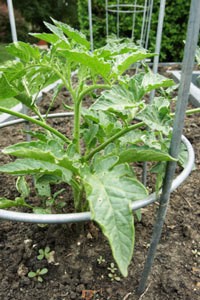
For many gardeners, tomatoes are one of the most prized vegetables in the garden. Whether you grow them in pots on your patio, or directly in your garden, staking them and training them to grow on supports will help reduce the potential of fruit loss due to sunburn, insects, and disease.
When properly pruned (suckered), tomato plants will produce larger fruits and produce them much earlier in the season than similar varieties that have not been pruned. Pruning tomatoes simply involves pinching off the small shoots (suckers) that develop where each leaf joins the stem. If not removed, energy that could be used for fruit production is wasted on growing suckers. The shoots should be removed when they are less than 4 inches long to prevent injuring the plant. Pruning is done throughout the lifespan of the plant, as suckers will continue to grow.
Determinate (self-topping) tomato varieties tend to grow in compact bush forms and produce most of their crop at one time. These varieties are heavily branched so they adapt well to staking and caging, but not to trellises. Prune them once to remove weak suckers.
Indeterminate tomato varieties set their fruit clusters along vines that continue to grow throughout the season. These varieties need to be heavily pruned when trellised (pruned to one main stem and strong sucker below the first bloom cluster), moderately pruned when staked (limited to 2-3 fruit-producing branches), and lightly pruned when using cages (limited to 3 to 5 fruit-producing branches).
The primary benefit of providing tomato plants support is to prevent of fruit loss from soil rot. Tomato plants grown on the ground and without supports can suffer as much as 15-50 percent total fruit loss depending on the variety and the growth habit of the plant.
Staking: Staking is done using a single metal or wooden stake at least 3 to 6 feet long and 1 inch thick. The stakes should be driven 12-18 inches into the ground. The stem of the plant is then secured to the stake with a soft tie. The advantage to using stakes for support is that they are inexpensive and take up very little room. They are also suitable for both determinate and indeterminate varieties of tomato plants.
Caging: Most gardeners are familiar with the circular metal cages made for supporting tomatoes. There are two main advantages to using these pre-made cages. They are quick and easy to maintain, and the fruits from plants grown in cages tend to suffer the least amount of sunburn. As far as disadvantages go, tomato cages are typically the most expensive type of support and take up the largest amount of space per plant. Caged tomatoes should be set at least 3 feet apart in a row. As plants continue to grow, turn the ends of the branches back in toward the center of the cage. Determinate varieties grown in cages require no pruning.
Trellises: This type of support system is limited to indeterminate varieties. Posts or stakes at least 4 feet high and 4 inches thick are set into the ground approximately 10 to 25 feet apart (depending on the number of plants being grown). A heavy gauge wire is then stretched from one post to around another and back again to create support.
H Supports: This type of support system works especially well for determinate varieties of tomatoes, because it keeps the fruit off the ground without the need for pruning or tying. Create two wooden H supports (think of a capital H) that are 2-3 feet wide and sit 8 to 10 inches off the ground. Place these supports 10 feet apart from each other in the garden so they are centered over your young tomato plants. Lay a piece of wide gauge fencing (like hog wire) across the supports and secure it at both ends. As the plants grow, simply pull them through the opening so the fence supports them.

About The Author: Ellen Brown is an environmental writer and photographer and the owner of Sustainable Media, an environmental media company that specializes in helping businesses and organizations promote eco-friendly products and services. Contact her on the web at http://www.sustainable-media.com
Add your voice! Click below to comment. ThriftyFun is powered by your wisdom!
I'm fairly new at gardening, having only done it for the past three years and, last weekend, I went out to the garden and noticed a lot of "suckers" sticking out of the tomato cages so I gathered them all up and loosely wrapped the cage with twine so that I could walk between the cages easily. Should I have pruned them? Can I still prune them, or should I just let them go?
Alot of gardeners now also love pot planting, so they don't have to worry about stakes. Good luck!!

Add your voice! Click below to comment. ThriftyFun is powered by your wisdom!